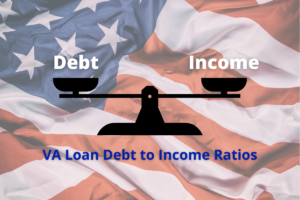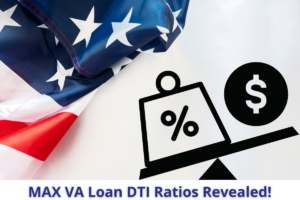VA Loan Debt to Income Ratio - DTI for VA Loan

Va Loans
REAL ESTATE FOR VETERANS
VA Loan Debt to Income Ratio

Peter Van Brady
Founder of SoCal VA Homes
Author: Avoiding Mistakes & Crushing Your Deals Using Your VA Loan
This brief video explains everything about the debt to income ratio for a VA Loan
Are you looking to buy a house and wondering what a good VA loan debt to income ratio could be to get qualified? The result of dividing your “potential” monthly obligations by your gross income is a percentage - a ratio that carries a lot of meaning for lenders. This is very important because your VA loan debt to income ratio, can be much, much more flexible in comparison to considering a conventional loan. The difference can be 65% vs. 45%! Watch this & read the details. It's EXTREMELY important!
That said, it’s not very difficult to calculate your ratios. Our Sr. VA Loan Professionals are happy to explain what it’s all about and what impact your debt-to-income (DTI) ratio has on trying to buy a new home.
Are you looking to buy a house and wondering what a good debt-to-income ratio is? The comparison of one number divided by another results in a percentage or ratio that carries a lot of meaning for lenders. You don’t want to underestimate the importance of your debt-to-income (DTI) ratio. That said, it’s not very difficult to calculate a debt-to-income ratio, and the VA loan specialists at SoCal VA Homes are happy to explain what it’s all about and what impact your DTI ratio has on trying to buy a new home.
What is DTI for a VA Loan?

Your debt to income ratio for a VA loan is a metric used to determine how much credit bandwidth a buyer has. The guideline gives lenders a way to measure whether a person can take on a mortgage and what reasonable mortgage amount the person can be responsible for. In other words, the smaller the monthly obligations in relation to the monthly income level, the better. The lower your VA loan DTI ratio, the more likely you will be to get approved for the mortgage amount you’ve applied for.
In contrast, lenders perceive those mortgage applications and their borrowers with a high DTI ratio as more likely to to default on their VA loan and are less likely to approve a loan application.
A quick aside on this topic: Some home buyers are confused by this topic and industry lingo! If you’re curious about your income-to-debt ratio, then you won’t find any answers because that upside down math isn’t relevant to lenders! Rearrange the phrases: talk to your lender about debt-to-income ratio, not income-to-debt ratio!
What is the MAX DTI for a VA Loan?

The maximum DTI ratio for conventional loans is typically 50%.
Yet, with an Automated Underwriting Approval, the max DTI for a VA loan can often exceed 65%!
That’s right. Your lofty VA loan DTI can allow you to afford much more home, as long as you meet Residual Income Guidelines.
As already mentioned, the VA loan debt-to-income ratio is very aggressive; it is very flexible. This is because VA lenders incorporate an extra factor that other underwriters do not consider, namely residual income.
Residual Income Is Critical
When calculating residual income, VA underwriters are reviewing payroll deductions and also estimating other cost of living factors including the size of the borrower’s family. Additionally, they include average monthly maintenance costs on the house. The idea here is to begin with the gross income, and after all the deductions and demands on family income, determine what’s left over to buy food!
Residual income is the amount left over, calculated by subtracting those expenses from your monthly income. When considering minimum amount of residual income a borrower needs, VA lenders account for the size of the buyer’s household and then cross reference the cost of living by geographic region across the country geography. Also called “discretionary income,” residual income provides the most realistic view of a person’s finances and helps to prevent foreclosures in the future.
All that said, be cautious. Funding your VA loan at the max DTI ratio might not be the best way to position your finances and as a VA buyer, but it’s good to know where you fall in terms of the expectations of lenders.
It’s also a good idea to ask yourself, what DTI ratio would best position you to both qualify for a mortgage large enough to get the home you want and put you in a healthy financial situation so that you can live in reasonable comfort with those mortgage payments? After making your monthly mortgage payment and taking care of monthly expenses, will you have enough income left over for savings and other pursuits?
If you are curious about an initial estimate of your monthly mortgage payments, try out our mortgage payment calculator for yourself.
How Do I Calculate DTI for a VA Loan?
If you don’t yet know how to figure your Debt-to-income ratio, it is calculated by dividing prospective monthly debt payments by monthly gross income. The resulting number is then given as a percentage. However, there are two forms of DTI ratios: a “front-end” ratio and a “back-end” ratio.”
It’s helpful to offer a well-rounded education on debt ratios, so we’ll do the deep dive! It’s also worth note that VA Loan DTI calculations only use the “back-end ratio.” Here's a helpful graphic explanation.
Front-End Ratio
The front-end ratio compares your proposed housing and mortgage expenses to your gross income, the amount of money you earn each month before taxes and all your payroll deductions. Housing expenses factored into the equation will include the mortgage principal reduction portion of the payment, the mortgage interest portion, property taxes, homeowner’s insurance, private mortgage insurance (not included in VA loans) and HOA fees. Front-end ratios are calculated by dividing the total housing costs by gross income.
For example, if your housing costs amount to $2,000 monthly and you earn $8,000 in gross income, your front-end ratio would be about 25%.
$2,000 (housing) ÷ $8,000 (gross income) = 25% front-end ratio
Each lender has a slightly different scale when determining ideal debt-to-income ratios, but a front-end ratio below 28% is generally considered conservative, although not always realistic with today’s higher home prices. So, across the board, a front-end DTI ratio of 25% would make it fairly easy to secure a mortgage from any lender.
Back-End Ratio
Again, with VA loan debt to income ratio calculations, this back-end ration is the important one. The back-end ratio measures the amount of your gross income that goes toward all existing monthly debt payments, including housing expenses. The back-end ratio factors in credit card payments, auto loans, installment payments, child support and any other monthly obligation, in addition to the same housing costs included in the front-end ratio. So, we can see that the back-end ratio is a much more all-inclusive metric and provides a wider view of a person’s finances.
To add on to the example used above, if you pay $1,000 toward debts on top of housing expenses amounting to $2,000, then your monthly debts add up to $3,000. We divide $3,000 by your gross income of $8,000 and find that your back-end ratio is 37.5%.
$3,000 (debts and housing) ÷ $8,000 (gross income) = 37.5% back-end ratio
Because VA lenders ignore front-end ratios and defer to back-end ratios instead, we’ll simply discuss one single number. The VA’s standard for maximum back-end DTI ratios is $41%. But individual mortgage underwriters are not required to use the same benchmark. If you are a Veteran and your VA loan debt-to-income ratio is above 41%, do not be discouraged. You may be approved in an Automated Underwriting scenario, as most VA loan applicants are.
Again, in contrast to loans underwritten for conventional guidelines, VA underwriters very often accommodate high debt-to-income ratios even in excess of 65%. With the necessity of automated underwriting systems and an additional underwriting calculation known as the borrower's residual income, VA loan underwriters can make your ideal home a reality!
Ready to have us calculate your debt to income ratio for a VA loan? Start here:
VA Loan Debt to Income Ratio Calculator
You might be wondering if there is a debt to income ratio calculator for VA Loans to help you figure out what your ideal ratios are and therefore your ideal purchase price. Go to our calculator. The slider bar ranges from 41% DTI to 65%+ DTI on our calculator.
Check it out. It's very handy!
What is an Ideal Debt-to-Income Ratio?
Lender-by-lender, they vary to some degree in what they consider an ideal DTI benchmark. For very conservative conventional underwriting, an ideal front-end ratio is no more than 28%, and in a perfect world, the back-end ratio should be no more than 36%. As automated underwriting systems and FICO scores have dominated the lending process, getting loans approved with higher DTI ratios have been more common.
VA lenders, on the other hand, primarily breakdown their underwriting of DTI ratios into two groups. In group one, because of the successes achieved with automated underwriting systems, many VA lenders do not have a maximum DTI ratio. Typically, with a high DTI ratio and an Approve/Eligible Recommendation from the automated underwriting system, VA lenders will allow the high DTI and then closely examine a borrower’s residual income when determining if a mortgage should achieve final approval.
Without that golden seal of “Approve/Eligible” from the system, VA borrowers would fall into the second group of borrowers, those that receive a traditional manual underwrite. This group would still be defined as having a good debt-to-income ratio for a VA loan, but would typically be 41% or less. Again, in this circumstance, the VA underwriter would apply manual underwriting guidelines found in the VA Lender’s Handbook.
For a more in-depth discussion about automated underwriting versus manual underwriting, we suggest you get a complimentary copy of Peter Van Brady’s book: Avoiding Mistakes & CRUSHING Your Deals Using Your VA Loan.
How Can I Lower My DTI Ratio?
You can lower your DTI ratio in two ways:
- Increase your income
- Decrease your debt (your monthly obligations)
Increase your income by changing jobs, renegotiating your current salary, or securing a side job. A side job can be a temporary situation until the bulk of your debt is gone, and your debt-to-income ratio is lowered. While at first, increasing your income might not be immediately feasible, there are numerous ways to decrease your debt.
Determine your Expenses
Lowering your DTI ratio begins with figuring out exactly what your finances look like, how much you earn, and what your monthly expenses are. Once you determine how you tend to spend your income each month, create a list of needs and wants. Creating a budget that prioritizes paying down debt will mean that monthly income goes toward “needs” and avoids buying from the list of “wants,” at least for the duration of time that you are decreasing debt and preparing to invest in a new home.
“Needs” are those purchases and services that you cannot live without in order to survive. This includes housing, food, utilities, gas in your car, health insurance, etc. The “wants” might be nice but they’re extra and optional. Avoiding purchases from the wants list actually adds up over time and will have a real effect on your bank account, getting you closer and closer to realizing the dream of homeownership.
Track your Spending
The importance of tracking your spending cannot be stressed enough. It’s best to study your spending on a weekly basis. But don’t let a month go by without checking your spending to see if you are actually staying within your budget and overall plan to lower debt.
Making debt “more affordable” is a possibility if you can lower the rates of high-interest credit cards. If you have a history of making payments on time and your account is in good standing, it doesn’t hurt to call the credit card company to ask about getting a lower interest rate or shopping other credit card companies to roll over the balance to achieve better terms.
Finally, consider seeing a financial planner or a professional who specializes in debt relief. However, be extremely cautious of anyone who tells you to stop making payments as a debt relief negotiating technique!
SoCal VA Homes is happy to talk with you more about your financial situation. We do want to emphasize, however, that VA home loans are much easier to qualify for than conventional loans, especially when you have a high DTI ratio. Don’t dismiss the possibility of getting a VA home loan if you think your DTI ratio is too high!
Debt-to-Income Ratio Unique Situations
Some borrowers find themselves in the unique position of having a good credit score but a high debt-to-income ratio. Their DTI can be too high for a VA loan, a financing option that is ordinarily more flexible and forgiving. This might be the case if you have gone on to attend medical school or graduate studies, acquiring high debt because of student loans. On paper, you will appear to be a risky borrower despite the fact that you have an excellent FICO score and can make your loan payments on time.
Recently the industry giant Fannie Mae signaled that a high DTI ratio will not hinder borrowers with strong credit scores, as high DTI ratios might have hindered obtaining a mortgage in the past. Fannie Mae announced they will lend to borrowers with DTI ratios upwards of 50%. There are two qualifications to this: the borrower must have at least twelve months of cash reserves on hand and the loan amount cannot be more than eighty percent of the property’s value.
To be realistic, many borrowers with excellent credit scores and an exceedingly high DTI ratio will not meet those requirements, especially for first-time homebuyers.
Advantages of the VA Loan DTI Limits
We can’t stress the overall benefits of the program enough and its liberal VA loan max DTI.
The signature feature of a VA home loan and what it is most known for, is that a down payment is not required. Even if you exceed conforming VA loan limits and get a jumbo loan, your down payment will likely still be zero.
With all of these factors combined, you will save an incredible amount of money upfront. Private mortgage insurance is not required, and there is flexibility in the amount of the VA funding fee that you may pay.
It’s important to know that your VA home loan benefit does not expire, and it can be used more than once. So even if you earned your benefit a long time ago or used it once before, it is still yours to use again and again!
VA home loans are guaranteed by the government, but they are not funded by or even originate from the VA. This means that you have options for mortgage underwriters; you can shop and compare VA home loan lenders. These lenders set their own rates and lending fees, so you can decide for yourself which lender option is best for your situation.
And that’s not all, Veterans can use their VA home loan benefits in a couple of different ways. Beyond purchasing a home, VA home loans can be used to refinance existing mortgages, make home improvements, and even construct a brand-new home from the ground up!
This is where we come in. SoCal VA Homes offers a set of unique and powerful VA programs for you to choose from as you move forward in the home buying process
Use Your VA Home Loan to Get the Right Loan for You
SoCal VA Homes knows that each borrower’s debt to income ratio for a VA loan is unique. We recognize the common challenges that Veterans frequently face when trying to use their hard-earned VA benefits to purchase a house. We are sympathetic to your goals because we are a team of military Veteran real estate agents and Sr. VA loan pros who are “VA Savvy.” We are serious about helping you on the path to homeownership. We are here to talk with you about the details of your VA benefits, to discuss your VA loan DTI and to help you move forward with one of our programs.
Our flagship program is the Dreamweaver Home Purchase Process. For this program, we work alongside you to locate just the right house for you and your family. Once we find the right house, SoCal VA Homes makes a cash offer on your behalf and then renovates the home according to your needs and preferences. Finally, SoCal VA Homes transfers (i.e., sells) the home to you.
We also offer a 100% VA Construction Loan. This program is appealing because you get to build your house from the ground up. We will help you locate a great piece of land and then oversee the construction of your new home. Think of all the customization you can do if you build a house from scratch!
The Veteran’s Angels Program is our most popular program with SoCal VA Homes’ clients. This program offers an advantage for VA homebuyers by utilizing a set of proven tactics to improve the likelihood of getting your offer accepted.
Call one of our Sr. VA Loan Professionals at 949-268-7742 today!
As Seen on ABC 10 5:00 O’Clock News












